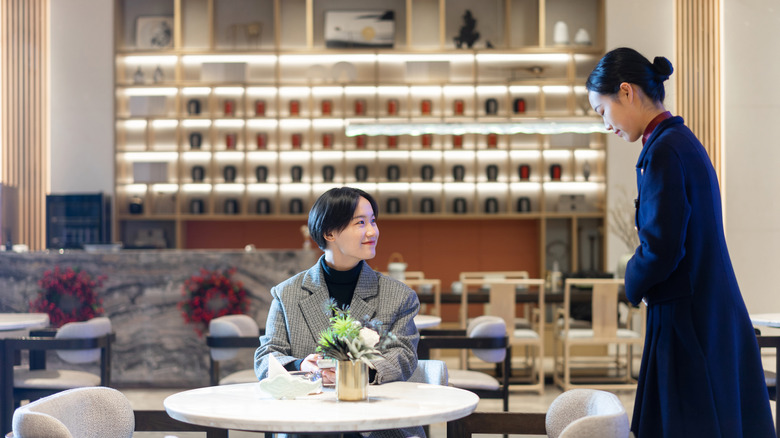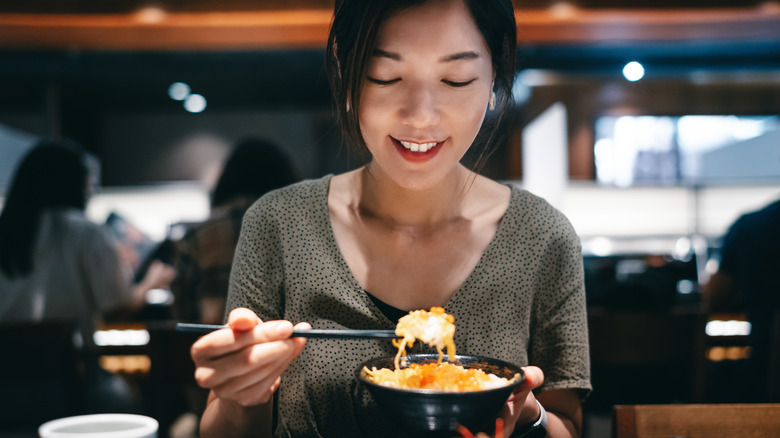This Rude Approach To Getting Your Waiter's Attention In America Is Very Common In Japan
Japan is one of the hottest countries in the world right now when it comes to receiving international visitors, and for good reason. Travelers are flocking to this island nation to experience its fascinating culture, wander its pulsing, colorful streets, and to dive into its most alluring destinations, such as this authentic onsen town surrounded by mountains.
Another big reason to visit Japan is for the food. From humble bowls of ramen at hole-in-the-wall noodle shops to high-end omakase sushi, Japanese cuisine runs the gamut from hearty to sublime, and savoring the food is an essential part of any visit to the country.
There are ways to be a considerate tourist in Japan and this also applies to dining out, where it pays to do your homework regarding restaurant etiquette. There are a host of customs and rules governing the way Japanese eat that are good to be aware of, such as avoiding this mistake with soy sauce. This also includes one rule that may surprise American visitors: Waving and calling out to your server to get their attention isn't considered rude. In fact, it's just that way it's done.
Don't be afraid to raise your hand and speak up at a restaurant
Because of tipping culture, restaurant service is often very attentive in the U.S. That said, if your server is very busy, it can sometimes be difficult to get their attention. The most common move in the States is to attempt to make eye contact when they're nearby, with perhaps a very slight wave of the hand. However, you would never raise your hand up high, snap your fingers, whistle, or worse yet — shout to your waiter. This is considered incredibly rude in the U.S. as it's seen as treating your server like a lowly servant.
However, things are done a bit differently in Japan. Servers will often ignore you until you let them know you need something, especially outside of heavily-touristed areas. While you can attempt eye contact, the most effective way to get the service you need is to raise your hand, and if need be, call out to them. Just say "sumimasen" at a decent volume, which translates to "excuse me" in Japanese.
While raising your hand is a surefire way to get what you need at a restaurant in Japan, many restaurants — especially family-style eateries — will also have call buttons on the table. Simply press the button and an electronic bell will sound, summoning your server in no time. Tablets and order screens are also more common these days, where you just pick what you want and touch the screen, though they may only be available in Japanese.
Other restaurant etiquette to be aware of in Japan
When sitting down for a meal at a restaurant in Japan, there are some other customs any considerate traveler should try to follow, such as never filling your own glass, and pouring for others with two hands. You should also avoid scraping your chopsticks together and make sure to lay them down across your rice bowl. Never stick them upright straight into the rice, as this is done in Japanese funerals as an offering to the departed.
Speaking of bowls, you will also find that the Japanese lift their rice and soup bowls up from the table before eating from them, which is considered good form, so don't be shy about following suit. Also, the little moist towels placed on the table before the meal are meant for wiping your hands. Don't use them to clean your face, or worse yet — the tabletop.
When you're finished eating, you can simply say "gososamadeshta," meaning, "the meal was satisfying," or "sumimasen, o-kaikei kudasai," which is how you ask for the check. Always pay at the cash register (you never settle your bill at the table in Japan), and don't leave tip. Not only is it completely unexpected, it could also come across as embarrassing or even offensive. For more on Japan's sometimes complicated etiquette rules, here are 13 things tourists should never do when visiting the Land of the Rising Sun.


